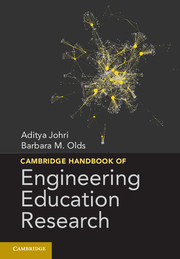Book contents
- Frontmatter
- Dedication
- Contents
- Editors
- Contributors
- Foreword
- Acknowledgments
- Introduction
- Chapter 1 Chronological and Ontological Development of Engineering Education as a Field of Scientific Inquiry
- Part 1 Engineering Thinking and Knowing
- Part 2 Engineering Learning Mechanisms and Approaches
- Part 3 Pathways into Diversity and Inclusiveness
- Chapter 14 Engineering Identity
- Chapter 15 Studying the Career Pathways of Engineers
- Chapter 16 Retention and Persistence of Women and Minorities Along the Engineering Pathway in the United States
- Chapter 17 Social Justice and Inclusion
- Chapter 18 Community Engagement in Engineering Education as a Way to Increase Inclusiveness
- Part 4 Engineering Education and Institutional Practices
- Part 5 Research Methods and Assessment
- Part 6 Cross-Cutting Issues and Perspectives
- Index
- References
Chapter 18 - Community Engagement in Engineering Education as a Way to Increase Inclusiveness
Published online by Cambridge University Press: 05 February 2015
- Frontmatter
- Dedication
- Contents
- Editors
- Contributors
- Foreword
- Acknowledgments
- Introduction
- Chapter 1 Chronological and Ontological Development of Engineering Education as a Field of Scientific Inquiry
- Part 1 Engineering Thinking and Knowing
- Part 2 Engineering Learning Mechanisms and Approaches
- Part 3 Pathways into Diversity and Inclusiveness
- Chapter 14 Engineering Identity
- Chapter 15 Studying the Career Pathways of Engineers
- Chapter 16 Retention and Persistence of Women and Minorities Along the Engineering Pathway in the United States
- Chapter 17 Social Justice and Inclusion
- Chapter 18 Community Engagement in Engineering Education as a Way to Increase Inclusiveness
- Part 4 Engineering Education and Institutional Practices
- Part 5 Research Methods and Assessment
- Part 6 Cross-Cutting Issues and Perspectives
- Index
- References
Summary
Introduction
There has been a recent surge in community engagement (CE) efforts in engineering education. These efforts have involved a spectrum of academic avenues – from curricular to co-curricular to extracurricular – that cover community-based projects in local to global settings. For example, many CE experiences can be embedded within courses in the traditional pedagogical form of service-learning, although in many cases CE activities are implemented and/or facilitated by nonacademic organizations, such as Engineers Without Borders (EWB). These activities continue to undergo increasing levels of design, management, and assessment, the latter driven, in part, by the outcomes assessment requirements for ABET engineering program accreditation in the United States, but also because of apparent positive impacts to student participants. Previous studies indicate that the knowledge and skills gained by the students are at least on par with gains from traditional education models (e.g., see Bielefeldt, Paterson, & Swan, 2010). Additional attention also is being focused increasingly on the potential impacts of CE on student attitudes and identity (Paterson, Swan, & Guzak, 2012) as well as long-term impacts on students as they enter the professional ranks (Canney & Bielefeldt, 2012). It is in these areas that differences in the influence of CE may appear more profound, yet small numbers of student participants in various programs and a lack of coordinated assessment efforts provide limited evidence that such results exist. This chapter highlights the development of CE in engineering education and possible research endeavors that can be taken to shed new light on its potential impact.
- Type
- Chapter
- Information
- Cambridge Handbook of Engineering Education Research , pp. 357 - 372Publisher: Cambridge University PressPrint publication year: 2014
References
- 26
- Cited by

